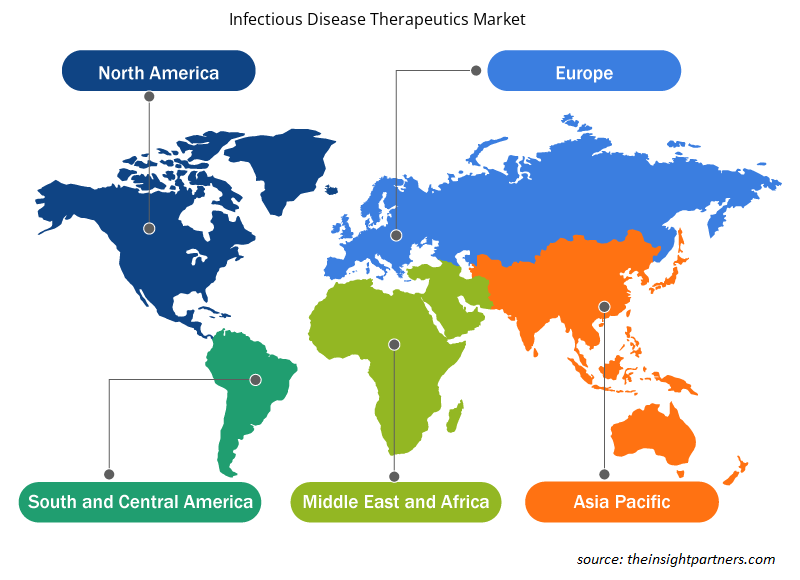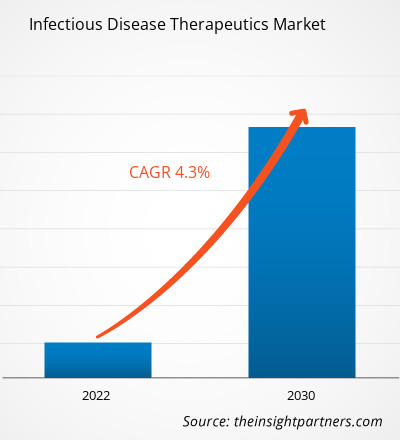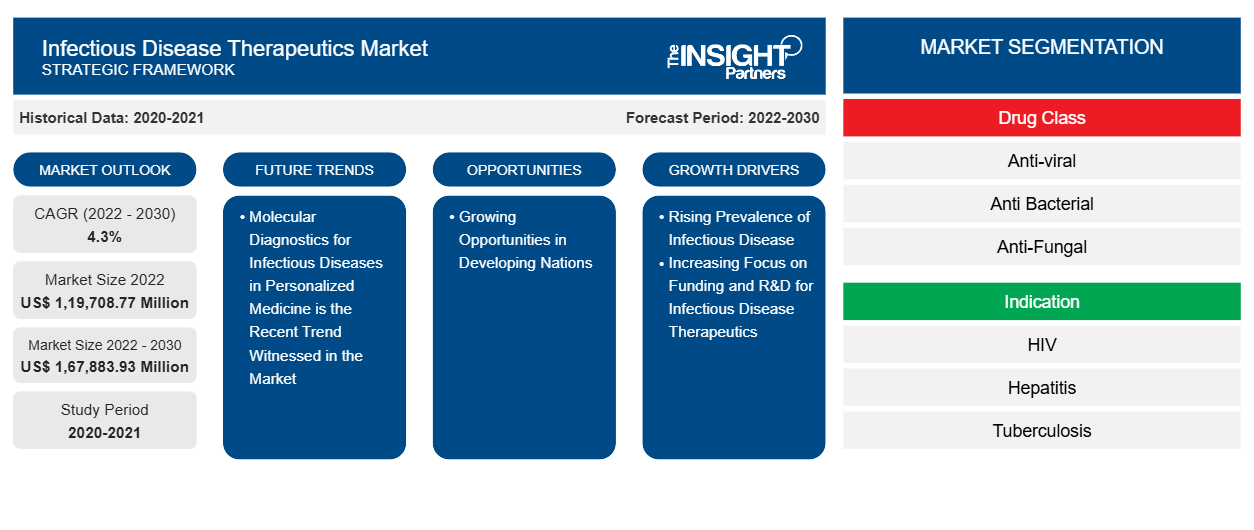La dimensione del mercato delle terapie per le malattie infettive nel 2022 era di 1.19.708,77 milioni di dollari USA e si prevede che raggiungerà 1.67.883,93 milioni di dollari USA entro il 2030. Si prevede che il mercato registrerà un CAGR del 4,30% nel periodo 2022-2030. È probabile che il numero crescente di approvazioni e lanci di prodotti rimanga una tendenza chiave nel mercato.
Analisi di mercato delle terapie per le malattie infettive
La crescente prevalenza di malattie infettive nella società, gli operatori del mercato hanno immesso sul mercato medicinali avanzati per il trattamento di disturbi infettivi e le iniziative intraprese dal governo per fornire ai cittadini strutture sofisticate per il trattamento delle malattie infettive stanno guidando il mercato.
Panoramica del mercato delle terapie per le malattie infettive
Batteri, virus, funghi e parassiti sono tutte creature che causano malattie infettive. Antibiotici, antivirali e antiparassitari sono alcuni dei farmaci usati per curare i disturbi infettivi. Le terapie per le malattie infettive potrebbero agire direttamente sugli organismi o aiutare il sistema immunitario del corpo a combattere le infezioni. Le malattie infettive includono HIV, tubercolosi, malaria , epatite e influenza, tra le altre.
Personalizza questo report in base alle tue esigenze
Riceverai la personalizzazione gratuita di qualsiasi report, comprese parti di questo report, o analisi a livello nazionale, pacchetto dati Excel, oltre a usufruire di grandi offerte e sconti per start-up e università
-
Scopri le principali tendenze di mercato in questo rapporto.Questo campione GRATUITO includerà analisi di dati che spaziano dalle tendenze di mercato alle stime e alle previsioni.
Driver e opportunità del mercato delle terapie per le malattie infettive
Maggiore attenzione al finanziamento e alla ricerca e sviluppo nella terapia delle malattie infettive per favorire la crescita del mercato
La ricerca e sviluppo (R&S) è una parte importante del business delle aziende farmaceutiche e biofarmaceutiche. La R&S consente alle aziende di lanciare nuovi prodotti per diverse applicazioni terapeutiche con un potenziale medico e commerciale significativo. Inoltre, i principali attori del mercato stanno investendo in R&S per sviluppare tecnologie avanzate e ottenere una maggiore quota di fatturato.
La tabella seguente mostra i finanziamenti annuali per varie categorie di malattie e ricerche sulla base di contratti, sovvenzioni e altri meccanismi di finanziamento utilizzati nei National Institutes of Health (NIH).
Malattie e finanziamenti
Malattia/Aree di ricerca |
2019 (milioni di dollari USA) |
2020 (milioni di dollari USA) |
2021 (milioni di dollari USA) |
2022 (milioni di dollari USA) |
|
Malattie infettive emergenti |
2.950 |
4.867 |
5.069 |
4.318 |
|
Malattie infettive |
6.313 |
8.301 |
8.599 |
8.019 |
|
Infezioni trasmesse sessualmente |
354 |
394 |
404 |
419 |
Nota: per le valute viene considerato il tasso di conversione corrente.
Fonte: Relazioni annuali e analisi di The Insight Partners
I principali progetti finanziati dai produttori:
• A giugno 2022, GSK plc ha investito 1,21 miliardi di dollari (1 miliardo di sterline) in 10 anni per accelerare la ricerca e lo sviluppo (R&S) incentrati sulle malattie infettive che colpiscono in modo sproporzionato le nazioni a basso reddito. La ricerca si concentrerà su nuovi medicinali e vaccini dirompenti per prevenire e curare la malaria, la tubercolosi, l'HIV (tramite ViiV Healthcare), le malattie tropicali neglette (NTD) e la resistenza antimicrobica (AMR).
• A marzo 2022, il meccanismo di risposta al COVID-19 del Fondo globale (C19RM) ha ricevuto una donazione di 48,07 milioni di dollari USA (60 milioni di CAD) dal Canada, che è stata elogiata dal Fondo globale per la lotta all'AIDS, alla tubercolosi e alla malaria. I nuovi fondi sono stati utilizzati per offrire ai paesi a basso e medio reddito trattamenti e test diagnostici essenziali, tra cui ossigeno medicale e dispositivi di protezione individuale (DPI).
Pertanto, la crescente attenzione rivolta alla ricerca e sviluppo e ai finanziamenti sta trainando la crescita del mercato delle terapie per le malattie infettive.
Crescenti opportunità nei paesi in via di sviluppo
Si prevede che la crescente prevalenza di malattie infettive migliorerà le vendite di farmaci per il trattamento delle malattie infettive nei paesi emergenti. Grazie ai minori requisiti di dati e alle leggi più severe, l'Asia Pacifica è emersa come una regione flessibile e favorevole alle imprese. Inoltre, i grandi investimenti nella ricerca sanitaria e nelle scienze della vita nei paesi emergenti svolgono un ruolo importante nel supportare la tecnologia all'avanguardia nei paesi in via di sviluppo, il che a sua volta incoraggia la tendenza verso la rilevazione e il trattamento delle malattie infettive. Ad esempio, l'UNAIDS chiede un investimento di 29 miliardi di dollari entro il 2025 per soddisfare le esigenze di prevenzione e trattamento dell'AIDS nei paesi a basso e medio reddito. In India, Corea del Sud, Brasile e Messico, malattie infettive come epatite, HAI, HIV e influenza sono diffuse; c'è una grande popolazione di pazienti; il denaro disponibile è aumentato; l'infrastruttura sanitaria è migliorata; e il turismo medico è in espansione. Pertanto, i produttori essenziali di prodotti terapeutici per le malattie infettive nell'espansione dei mercati terapeutici per le malattie infettive in queste nazioni dovrebbero aspettarsi prospettive redditizie in futuro.
Analisi della segmentazione del rapporto di mercato sulla terapia delle malattie infettive
I segmenti chiave che hanno contribuito alla derivazione dell'analisi di mercato dei farmaci terapeutici per le malattie infettive sono la classe del farmaco, l'indicazione, la via di somministrazione, il canale di distribuzione.
- In base alla classe di farmaci, il mercato delle terapie per le malattie infettive è suddiviso in antivirali, antibatterici, antimicotici e altri. Il segmento antivirale ha detenuto la quota di mercato maggiore nel 2022.
- Per indicazione, il mercato è segmentato in HIV, epatite, tubercolosi, influenza, HPV e altri. Il segmento HIV ha detenuto la quota maggiore del mercato nel 2022.
- In termini di via di somministrazione, il mercato è segmentato in orale, parenterale, topico e altri. Il segmento dei produttori orali ha detenuto la quota maggiore del mercato nel 2022.
- In base al canale di distribuzione, il mercato delle terapie per le malattie infettive è suddiviso in farmacie ospedaliere, farmacie al dettaglio e altre. Il segmento delle farmacie ospedaliere ha detenuto la quota di mercato maggiore nel 2022.
Analisi della quota di mercato dei prodotti terapeutici per le malattie infettive per area geografica
L'ambito geografico del rapporto sul mercato delle terapie per le malattie infettive è suddiviso principalmente in cinque regioni: Nord America, Asia Pacifico, Europa, Medio Oriente e Africa, e Sud e Centro America.
Il Nord America ha dominato il mercato. Si prevede che la crescente adozione di progressi tecnologici e le crescenti attività di ricerca e sviluppo accelereranno la crescita del mercato delle terapie per le malattie infettive. Inoltre, le grandi aziende sanitarie e la crescente domanda di soluzioni terapeutiche avanzate per trattare condizioni croniche e malattie virali stanno spingendo l'espansione del mercato in questa regione.
Approfondimenti regionali sul mercato delle terapie per le malattie infettive
Le tendenze regionali e i fattori che influenzano il mercato delle terapie per le malattie infettive durante il periodo di previsione sono stati ampiamente spiegati dagli analisti di Insight Partners. Questa sezione discute anche i segmenti e la geografia del mercato delle terapie per le malattie infettive in Nord America, Europa, Asia Pacifico, Medio Oriente e Africa e Sud e Centro America.

- Ottieni i dati specifici regionali per il mercato delle terapie per le malattie infettive
Ambito del rapporto di mercato sulla terapia delle malattie infettive
| Attributo del report | Dettagli |
|---|---|
| Dimensioni del mercato nel 2022 | 1.19.708,77 milioni di dollari USA |
| Dimensioni del mercato entro il 2030 | 1.67.883,93 milioni di dollari USA |
| CAGR globale (2022-2030) | 4,3% |
| Dati storici | 2020-2021 |
| Periodo di previsione | 2022-2030 |
| Segmenti coperti |
Per classe di farmaci
|
| Regioni e Paesi coperti |
America del Nord
|
| Leader di mercato e profili aziendali chiave |
|
Densità degli attori del mercato della terapia delle malattie infettive: comprendere il suo impatto sulle dinamiche aziendali
Il mercato dei prodotti terapeutici per le malattie infettive sta crescendo rapidamente, spinto dalla crescente domanda degli utenti finali dovuta a fattori quali l'evoluzione delle preferenze dei consumatori, i progressi tecnologici e una maggiore consapevolezza dei benefici del prodotto. Con l'aumento della domanda, le aziende stanno ampliando le loro offerte, innovando per soddisfare le esigenze dei consumatori e capitalizzando sulle tendenze emergenti, il che alimenta ulteriormente la crescita del mercato.
La densità degli operatori di mercato si riferisce alla distribuzione di aziende o società che operano in un particolare mercato o settore. Indica quanti concorrenti (operatori di mercato) sono presenti in un dato spazio di mercato in relazione alle sue dimensioni o al valore di mercato totale.
Le principali aziende che operano nel mercato della terapia delle malattie infettive sono:
- Pfizer Inc
- Società per azioni Gilead Sciences Inc.
- F. Hoffmann-La Roche Ltd
- Shionogi & Co Ltd
- Bayer AG
- BioCryst Pharmaceuticals Inc
Disclaimer : le aziende elencate sopra non sono classificate secondo un ordine particolare.

- Ottieni una panoramica dei principali attori del mercato delle terapie per le malattie infettive
Notizie e sviluppi recenti sul mercato delle terapie per le malattie infettive
Il mercato delle terapie per le malattie infettive viene valutato raccogliendo dati qualitativi e quantitativi post-ricerca primaria e secondaria, che includono importanti pubblicazioni aziendali, dati di associazioni e database. Di seguito sono elencati alcuni degli sviluppi nel mercato delle terapie per le malattie infettive:
- Roche ha lanciato i primi test per le malattie infettive e cobas omni–Utility Channel per l'uso sul sistema cobas 5800 nei paesi che accettano il marchio CE. Il cobas omni–Utility Channel sul sistema cobas 5800 consente un menu di test più ampio consolidando i test a canale aperto con i test diagnostici in vitro (IVD) di Roche su un'unica piattaforma. (Fonte: F. Hoffmann-La Roche Ltd, comunicato stampa, dicembre 2022)
Copertura e risultati del rapporto sul mercato delle terapie per le malattie infettive
Il rapporto "Dimensioni e previsioni del mercato delle terapie per le malattie infettive (2020-2030)" fornisce un'analisi dettagliata del mercato che copre le seguenti aree:
- Dimensioni e previsioni del mercato delle terapie per le malattie infettive a livello globale, regionale e nazionale per tutti i principali segmenti di mercato coperti dall'ambito
- Tendenze del mercato delle terapie per le malattie infettive e dinamiche di mercato come fattori trainanti, limitazioni e opportunità chiave
- Analisi dettagliata delle cinque forze PEST/Porter e SWOT
- analisi di mercato delle terapie per le malattie infettive che copre le principali tendenze di mercato, il quadro globale e regionale, i principali attori, le normative e i recenti sviluppi del mercato
- Analisi del panorama industriale e della concorrenza che copre la concentrazione del mercato, l'analisi della mappa di calore, i principali attori e gli sviluppi recenti per il mercato della terapia delle malattie infettive
- Profili aziendali dettagliati
- Analisi storica (2 anni), anno base, previsione (7 anni) con CAGR
- Analisi PEST e SWOT
- Valore/volume delle dimensioni del mercato - Globale, Regionale, Nazionale
- Industria e panorama competitivo
- Set di dati Excel
Report recenti
Testimonianze
Motivo dell'acquisto
- Processo decisionale informato
- Comprensione delle dinamiche di mercato
- Analisi competitiva
- Analisi dei clienti
- Previsioni di mercato
- Mitigazione del rischio
- Pianificazione strategica
- Giustificazione degli investimenti
- Identificazione dei mercati emergenti
- Miglioramento delle strategie di marketing
- Aumento dell'efficienza operativa
- Allineamento alle tendenze normative























 Ottieni un campione gratuito per - Mercato delle terapie per le malattie infettive
Ottieni un campione gratuito per - Mercato delle terapie per le malattie infettive